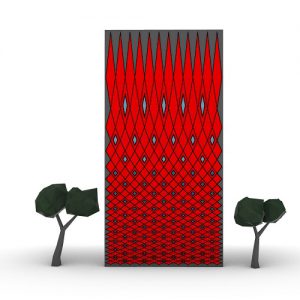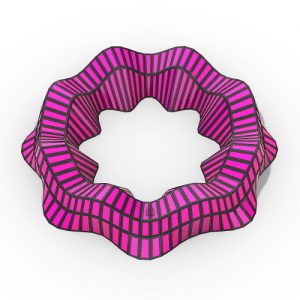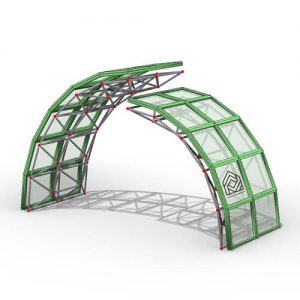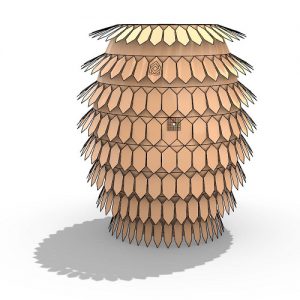Grasshopper Kangaroo Ideas
In this Grasshopper example file, you can model a parametric hexagonal structure using the Lunchbox plugin combined with multi-pipe and Mesh+.
In this simple Grasshopper example file, you can model a parametric 2D truss by defining two parametric curves.
In this grasshopper example, you can model a deployable membrane structure parametrically using the Anemone , LunchBox & Pufferfish plugin.
in this grasshopper example file, you can design a diamond shape facade and change the size of the panels with Graphmapper. This project is inspired by the "Ginza Place " of Klein Dytham architecture + TAISEI DESIGN Planners Architects & Engineers.
In this Grasshopper example file you can create a pattern using a combination of Lunchbox and the basic Grasshopper components.
In this grasshopper example file you can design a parametric facade by using the lunchbox plugin.
In this Rhino Grasshopper example file you can use the native grasshopper components to model a deforming parametric tower and then use the Pufferfish and Lunchbox plugin for adding more details.
In this Grasshopper example file you can use the Lunchbox plugin to model a parametric pavilion .
In this grasshopper example file, you can model a parametric pavilion with a series of foldes triangular panels.
In this example file you can design a kinetic facade with horizontal and vertical panels using the Lunchbox plugin.
In this Grasshopper example file you can use the Lunchbox plugin to model a parabola based pavilion.
In this grasshopper example file, you can Create a 2D Diamond grid with the LunchBox Plugin on a Surface and then slide the strips of the pattern with WarpWeft Component of Kangaroo 2 Plugin.
In this grasshopper example file you can design a parametric facade by rotating a series of triangular panels using the Lunchbox plugin
In this grasshopper file you can create a parametric facade from the series of random points and using the Lunchbox plugin.
In this example file you can you can design a parametric folding origami covered with Diamond panels using the Parakeet, LunchBox, Crane & Meshplus plugins.
In this grasshopper example file You can use the lunchbox plugin to design a parametric wave-like facade.
In this grasshopper example file You can use the Lunchbox to give a Nurbs surface random openings.
in this grasshopper example file, you can create a parametric building with Tween Curves component and then use the LunchBox & Parakeet Plugins to generate different patterns on it.
In this grasshopper example file, you can Create a 2D pattern with the LunchBox Plugin on a wall & then Use the "Graph mapper" component to generate a parametric Wall Shelf.
In this grasshopper example file You can model a wave-like form and use the Lunchbox & Weaverbird plugin to generate the final patterns.
In this Grasshopper example file you can model a parametric arc structure and then use the lunchbox plugin to generate a diamond-like pattern on it .
In this grasshopper example file You can use the Lunchbox plugin + Weaverbird to generate a parametric space frame structure.
In this grasshopper example file You can model a parametric triangular-based roof by using the Lunchbox & Pufferfish plugin.
In this grasshopper example file you can create a space frame structure on a parametric Nurbs surface.
In this grasshopper example file You can use the Lunchbox plugin to model a parametric Space frame structure for a roof.
In this grasshopper example file You can model a parametric arc and convert it into a space frame structure and control the division.
In this grasshopper example file You can use the lunchbox plugin to generate Hexagonal cells on a base surface.
In this grasshopper example file You can design a Parametric tower by rotating the panel faces along an axis and using a point attractor .
In this grasshopper example file You can model a parametric facade with a series of panles which respond to a point attractor or a curve attractor.
In this grasshopper example file you can create parametric tower covered by a hexagonal structure pattern using the Lunchbox plugin.
In this grasshopper example file, You can model a parametric truss by using the kangaroo physics plugin.
In this advanced lesson, we are going to convert the relaxed mesh into a NURBS surface and learn how to penalize it using Weaverbird, Kangaroo, and Lunchbox.
In this grasshopper example file by panelizing a surface you can morph any given module inside it by using the "morph to twistedbox" component from pufferfish.
In this Paracourse Lesson, we are going to model a parametric freeform surface by defining two sections and a polar based rail. Then we are going to model a series of trusses and convert the surface into triangular panels.
In this grasshopper definition by modeling two series of parametric curves and then using the Lunchbox plugin you can model a parametric truss.
In this Rhino Grasshopper Architecture tutorial, we are going to model a parametric facade from scratch. The windows will extrude based on the height of the panels and we will use the Lunchbox plugin to model the Panels.
In this grasshopper definition a 2d pattern panel is created using the diamond panels of the Lunch box plug-in and different variants of the diamond panel is created using basic components to control thickness and shape.
In this Paracourse Lesson, we are going to optimize the shape of a space truss using Grasshopper and Galapagos. First, we are going to explain how to make the space truss by using two parametric surfaces and the Lunchbox component and then we are using the Millipede Plugin to optimize the structure.
In this Rhino Grasshopper Tutorial, we will model a perforated parametric facade in Grasshopper and with the help of Lunchbox Plugin. First, we will model the surface and then divide them into triangular panels. By using the attractor point technique we will make the panels scale differently across the facade.
In this Rhino Grasshopper tutorial, I will model a series of panels which change their size based on point attractors. First, we will use the lunchbox plugin to make the facade and then we use the attractor technique to scale the panels in one direction and finish the Parametric Facade.
In this Lunchbox grasshopper tutorial, I will show you how you can make complete diamond panels on a closed NURBS surface. First, we will use the lunchbox plugin to produce the panels and then we fix the triangle panels by combining them into diamonds and finally combine them back together.
In this Parametric Facade tutorial, I will show you how you can use multiple dispatches to produce a parametric facade. First, we will use a simple curved surface for the facade and then we will use the Lunchbox plugin to panel it with triangles. Then we will work on the vertices of the triangles to finish the modeling.
In this Grasshopper Tutorial, I will talk about the Space Truss Structure 1 from the Lunchbox plugin. First I will make a freeform Surface and then I will use this tool to convert it to a Space Truss Structure and at the end, you will learn how you can use grasshopper to model some of the structure's details.













































